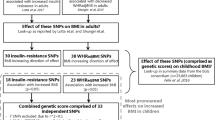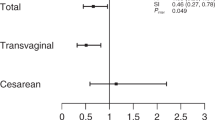Abstract
Background/objectives:
In Samoa, where 80% of the adult population is living with obesity, understanding the determinants of adiposity and growth during infancy may inform prevention efforts. We examined the association of a missense variant, rs373863828, in the CREBRF gene with body composition in Samoan infants. Adults with one or more copies of the rs373863828 minor allele (A) have higher odds of obesity, based on body-mass index (BMI), but paradoxically decreased odds of diabetes compared to those without the allele. Our study may offer novel insight into the natural history and pathogenesis of this unexpected relationship.
Subjects/methods:
In a prospective study, we measured body composition in early infancy, and at 2- and 4-months of age using anthropometry and dual-energy x-ray absorptiometry (DXA). We genotyped subjects at the CREBRF rs373863828 locus and compared infants with (AA/AG) and without (GG) the variant. In longitudinal analyses, we calculated the absolute change in each outcome from the early infant to the 4-month assessment, adjusting for baseline and other covariates.
Results:
In cross-sectional analyses, there was no significant difference in infant BMI or fat mass by genotype. After adjusting for covariates, infants with the variant had 4.0 ± 1.8 g more bone mass (p = 0.026) and 210.9 ± 79.6 g more lean mass (p = 0.009) at 4-months and accumulated 176.9 ± 73.0 g more lean mass between the early infant and 4-month assessment (p = 0.017).
Conclusions:
The CREBRF rs373863828 minor allele (A) was not associated with increased BMI or adiposity in Samoan infants, but instead with increased lean and bone mass. Our findings suggest that lean (i.e., muscle) and bone mass accretion should be explored as pathways to explain the “protective” effect of the CREBRF variant against diabetes.
This is a preview of subscription content, access via your institution
Access options
Subscribe to this journal
Receive 12 print issues and online access
$259.00 per year
only $21.58 per issue
Buy this article
- Purchase on Springer Link
- Instant access to full article PDF
Prices may be subject to local taxes which are calculated during checkout

Similar content being viewed by others
References
Hawley NL, McGarvey ST. Obesity and diabetes in Pacific Islanders: the current burden and the need for urgent action. Curr Diab Rep. 2015;15:29.
Hodge A, Dowse G, Toelupe P, Collins V, Imo T, Zimmet P. Dramatic increase in the prevalence of obesity in western Samoa over the 13-year period 1978-1991. Int J Obes Relat Metab Disord. 1994;18:419–28.
McGarvey S, Baker PT. The Effects of Modernization and Migration on Samoan Blood Pressures. Hum Biol. 1979;51:461–79.
Seiden A, Hawley NL, Schulz D, Raifman S, Mcgarvey ST. Long-term trends in food availability, food prices, and obesity in samoa. Am J Hum Biol. 2012;24:286–95.
Minster RL, Hawley NL, Su C, Sun G, Kershaw EE, Cheng H, et al. A thrifty variant in CREBRF strongly influences body mass index in Samoans. Nat Genet. 2016;48:1049–54.
Loos RJF, Yeo GSH. The bigger picture of FTO—the first GWAS ‑ identified obesity gene. Nat Publ Gr. 2013;10:51–61.
Naka I, Furusawa T, Kimura R, Natsuhara K, Yamauchi T, Nakazawa M, et al. A missense variant, rs373863828-A (p.Arg457Gln), of CREBRF and body mass index in Oceanic populations. J Hum Genet. 2017;62:847–9.
Ohashi J, Naka I, Furusawa T, Kimura R, Yamauchi T, Nakazawa M, et al. Association study of CREBRF missense variant (rs373863828: G>A; p. Arg457Gln) with levels of serum lipid profile in the Pacific populations. Ann Hum Biol. 2018;45:215–9.
Berry SD, Walker CG, Ly K, Snell RG, Atatoa Carr PE, Bandara D, et al. Widespread prevalence of a CREBRF variant amongst Māori and Pacific children is associated with weight and height in early childhood. Int J Obes. 2018;42:603–7.
Krishnan M, Major TJ, Topless RK, Dewes O, Yu L, Thompson JMD. Discordant association of the CREBRF rs373863828 A allele with increased BMI and protection from type 2 diabetes in Māori and Pacific (Polynesian) people living in Aotearoa / New Zealand. Diabetologia. 2018;61:1603–13.
Hanson RL, Safabakhsh S, Curtis JM, Hsueh WC, Jones LI, Aflague TF, et al. Association of CREBRF variants with obesity and diabetes in Pacific Islanders from Guam and Saipan. Diabetologia. 2019;62:1647–52.
Karsenty G, Ferron M. The contribution of bone to whole-organism physiology. Nature. 2012;481:314–20.
Hong S, Chang Y, Jung H, Yun KE, Shin H, Ryu S. Relative muscle mass and the risk of incident type 2 diabetes: a cohort study. PLoS ONE. 2017;12:e0188650.
Gillman MW. Early infancy–a critical period for development of obesity. J Dev Orig Health Dis. 2010;1:292–9.
World Bank. GDP-Samoa [Internet]. World Bank Natl. accounts data, OECD Natl. Accounts data files. World Bank; 2018; Available from: https://data.worldbank.org/indicator/NY.GDP.MKTP.CD?locations=WS.
Samoa Bureau of Statistics. Demographic and Health Survey. Apia, Samoa: Samoa Bureau of Statistics; 2014.
Pye D, Hannan W, Hesp R. Effective dose equivalent in dual X-ray absorptiometry. Br J Radiol. 1991;63:149.
Lewis MK, Blake GM, Fogelman I. Osteoporosis international original article patient dose in dual X-ray absorptiometry. Osteoporos Int. 1994;4:11–5.
Njeh C, Samat S, Nightingale A, McNeil E, Boivin C. Radiation dose and in vitro precision in paediatric bone mineral density measurement using dual x-ray absorptiometry. Br J Radiol. 1997;70:719–27.
Thomas S, Kalwalf H, Buckley D, Heubi J. Effective dose of dual energy x-ray absorptiometry scans in children as a function of age. J Clin Densitom. 2005;8:415–22.
Blake GM, Naeem M, Boutros M. Comparison of effective dose to children and adults from dual X-ray absorptiometry examinations. Bone. 2006;38:935–42.
Steel SA, Baker AJ, Saunderson JR. An assessment of the radiation dose to patients and staff from a Lunar Expert-XL fan beam densitometer. Physiol Meas. 1998;19:17–26.
National Council on Radiation Protection and Measurements. Ionizing radiation exposure of the population of the United States. Bethesda, MD: National Council on Radiation Protection and Measurements; 1987.
WHO Multicentre Growth Reference Study Group. WHO Child Growth Standards: Length/height-for-age, weight-for-age, weight-for-length, weight-for-height and body mass index-for-age: methods and development. Geneva, Swizterland: WHO Multicentre Growth Reference Study Group; 2006.
Holston A, Stokes T, Olsen C, Choi YS, Curtis J, Higginson J, et al. Novel noninvasive anthropometric measure in preterm and full-term infants: Normative values for waist circumference:length ratio at birth. Pediatr Res. 2013;74:299–306.
Swinburn BA, Ley SJ, Carmichael HE, Plank LD. Body size and composition in Polynesians. Int J Obes. 1999;23:1178–83.
Centers for Disease Control and Prevention. The Questionnaires: Centers for Disease Control and Prevention; 2008. https://www.cdc.gov/breastfeeding/data/ifps/questionnaires.htm.
Hawley NL, Johnson W, Nu’usolia O, McGarvey ST. The contribution of feeding mode to obesogenic growth trajectories in American Samoan infants. Pediatr Obes. 2012;9:1–13.
Roubenoff R, Kehayias J, Dawson-Hughes B, Heymsfield S. Use of dual-energy x-ray absorptiometry in body-composition studies: not yet a “gold standard.” Am J Clin Nutr. 1993;58:589–91.
Johnson W. Analytical strategies in human growth research. Am J Hum Biol. 2015;83:69–83.
Major T, Krishnan M, Topless R, Dewes O, Thompson J, de Zoysa J, et al. Re: “Widespread prevalence of a CREBRF variant among Māori and Pacific children is associated with weight and height in early childhood.” Int J Obes. 2018;42:1389–91.
Sovio U, Mook-kanamori DO, Warrington NM, Lawrence R, Timpson NJ. Association between common variation at the FTO locus and changes in body mass index from infancy to late childhood: the complex nature of genetic association through growth and development. PLoS Genet. 2011;7:1–13.
Alexander T, Conlon CA, Gamble G, von Hurst PR, van Dorp L, Ichhpuniani B, et al. Body composition of New Zealand-born term babies differs by ethnicity, gestational age and sex. Early Hum Dev. 2019;140:2–6.
Bassett DRJ. Skeletal muscle characteristics: relationships to cardiovascular risk factors. Med Sci Sports Exerc. 1994;26:957–66.
Liu D-M, Mosialou I, Liu J-M. Bone: another potential target to treat, prevent and predict diabetes. Diabetes Obes Metab. 2018;20:1817–28.
Zoch ML, Abou DS, Clemens TL, Thorek DLJ, Riddle RC. In vivo radiometric analysis of glucose uptake and distribution in mouse bone. Bone Res. 2016;4:1–8.
Eckel J. Myokines in metabolic homeostasis and diabetes. Diabetologia. 2019;62:1523–8.
Acknowledgements
This research was funded by grants from MacMillan Center for International Dissertation Research Fellowships at Yale University; the National Institutes of Health grant number [2 R01 HL093093]; and the National Science Foundation grant number [BCS DDRIG 1749911]. We thank the participating mothers and their infants and the midwives and doctors at Samoa National Health Services who contributed to the study. We would also like to thank Elise Claffey and Madison Rodman for their contributions to data collection, Richard Bribiescas for his support with the study design, and Claudia Valeggia for her feedback on drafts of this manuscript.
Author information
Authors and Affiliations
Corresponding author
Ethics declarations
Conflict of interest
The authors declare that they have no conflict of interest.
Additional information
Publisher’s note Springer Nature remains neutral with regard to jurisdictional claims in published maps and institutional affiliations.
Rights and permissions
About this article
Cite this article
Arslanian, K.J., Fidow, U.T., Atanoa, T. et al. A missense variant in CREBRF, rs373863828, is associated with fat-free mass, not fat mass in Samoan infants. Int J Obes 45, 45–55 (2021). https://doi.org/10.1038/s41366-020-00659-4
Received:
Revised:
Accepted:
Published:
Issue Date:
DOI: https://doi.org/10.1038/s41366-020-00659-4



